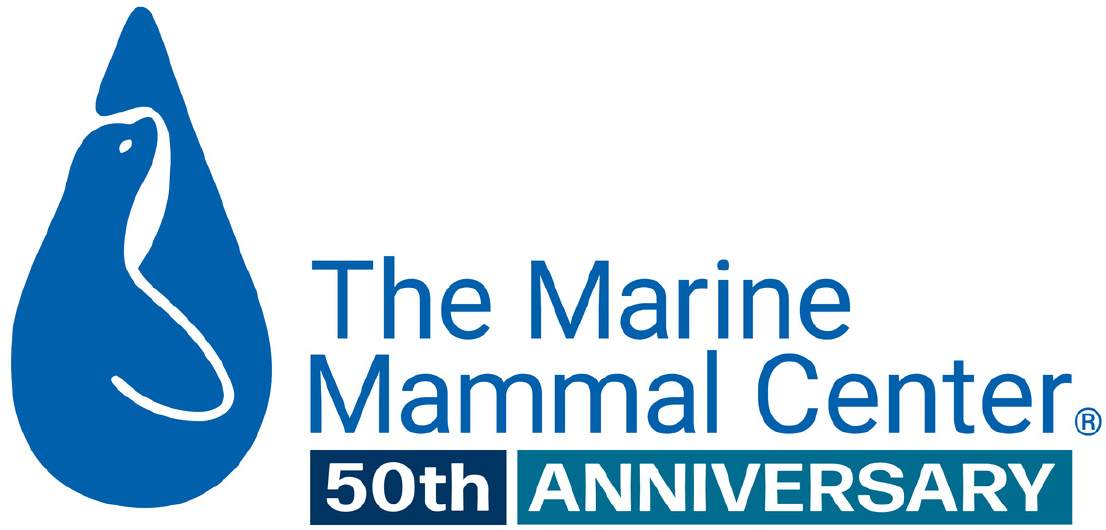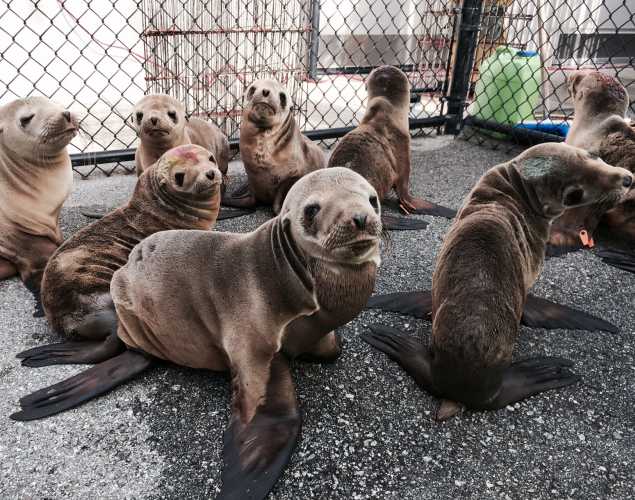
As Sea Lion Crisis Continues, Pups Like Percevero Are Desperate
- Malnutrition
- Climate change
Starving and too young to care for themselves, sea lion pups in search of food are sometimes found in the strangest places. The lucky ones end up in the care of experts at The Marine Mammal Center.
In the first three months of 2015, The Marine Mammal Center has rescued nearly as many California sea lions as we did during all of 2014.
Most of these sea lions are pups that should still be with their mothers on the Channel Islands. But sea lion mothers are having trouble finding enough food to sustain themselves and the pups they are nursing, so many of these young animals are left starving on the islands for days at a time.
Some pups tire of waiting and take off on their own—and the lucky ones end up coming ashore. A few of these pups are so desperate for food that they don’t stop at the shoreline. This is the story of one of those pups.
Why Did the Sea Lion Cross the Road?
At 7:10 a.m. on February 11, National Park Ranger Matt Wallat was driving along Skyline Boulevard near Fort Funston in the Golden Gate National Recreation Area when he stopped to assist two citizens guarding a California sea lion pup that had just crossed the four-lane road.
Ranger Wallat positioned his vehicle in the lane of traffic to further protect the pup until it could be moved into an animal crate for transport to The Marine Mammal Center for care. After arriving at the Center, Ranger Wallat was given the opportunity to name the pup he helped rescue. He suggested “Percevero,” meaning “to persevere” in Latin, a name quite apt for this pup who seemed determined to survive.
Percevero weighed just 30 pounds when he was admitted to our hospital. A healthy pup his age would weigh about 40 pounds. In addition to being underweight, Percevero was dehydrated and malnourished. An admit exam revealed that he was also suffering from parasites and mild pneumonia.
Percevero was immediately started on a course of fluids as well as tube-feedings of life-saving fish mash, made from ground-up herring and water. Animal care experts at the Center added Percevero’s medications to his daily tube-feedings as well: antibiotics for his pneumonia and a de-wormer for the parasites.
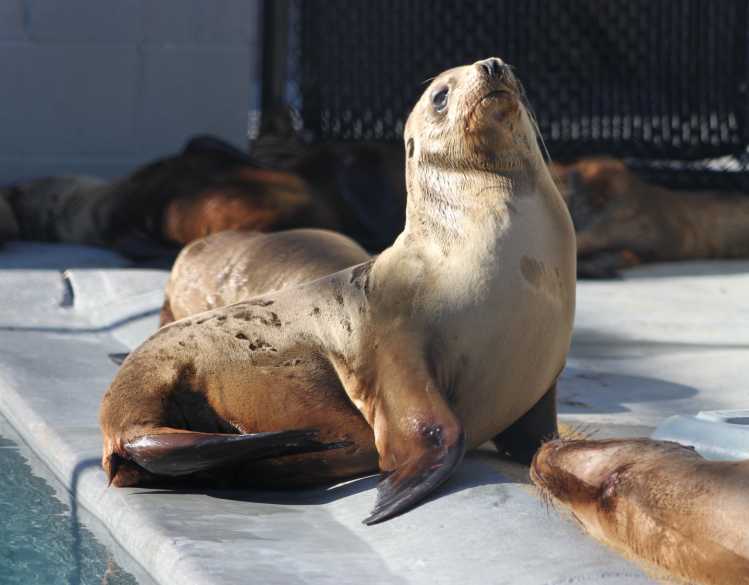
Learn More About the Patient Journey from Rescue to Release
{"image":"\/Animals\/Patients\/Rescues\/cropped-images\/pebble-beach-rescue-by-brian-simuro-c-the-marine-mammal-center-0-498-4764-2679-1602033141.jpeg","alt":"","label":"Patient Journey","title":"Rescue","link_url":"\/animal-care\/patient-journey\/rescue","type":"page"}
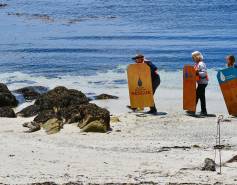
{"image":"\/People\/Action\/Volunteers\/topside-crew-by-bill-hunnewell-c-the-marine-mammal-center.jpg","alt":"","label":"Patient Journey","title":"Rehabilitation","link_url":"\/animal-care\/patient-journey\/rehabilitation","type":"page"}

{"image":"\/Animals\/Patients\/California sea lions\/csl-release-by-bill-hunnewell-c-the-marine-mammal-center.jpg","alt":"","label":"Patient Journey","title":"Release","link_url":"\/animal-care\/patient-journey\/release","type":"page"}

Once Percevero grew strong enough, he was able to transition to eating whole fish. After six weeks of care, Percevero had nearly doubled in size, gaining 23 pounds. After proving he could compete for fish with his sea lion pen-mates, Percevero was given a final exam and cleared for release.
On March 30, Percevero returned to the wild at Chimney Rock in Point Reyes National Seashore along with six other young sea lions. Ranger Wallat attended the release to see Percevero and his friends return home.
“It’s very gratifying to see Percevero and the other sea lions get a second chance to live healthy and productive lives in the ocean,” Wallat said. “We need to keep in mind that the tremendous work that goes into their rehabilitation must be matched by our efforts to protect our environment.”
NOAA officials say that the waters in this area north of San Francisco have cooled in recent weeks and fish are available, giving these healthy young animals a good chance to make it on their own.
So far this year, The Marine Mammal Center has released more than 100 healthy animals back to the wild, many of them young sea lions just like Percevero.
You Can Make a Difference
We’re using more than 1,000 pounds of fish a day to feed all of our patients—and at $1 a pound, our food bills are adding up. Support our Dollar-a-Pound campaign to help give all of our patients a second chance at life.
Yes, I want to save a life!
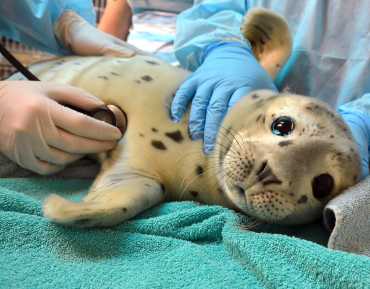
Yes, I want to save a life!
You’ll be giving sick and injured animals the best possible care at the Center’s state-of-the-art hospital. With your gift today, you are giving a patient a second chance at life in the wild.
See Our Latest News
{"image":"\/Animals\/Patients\/Hawaiian monk seals\/2025\/cropped-images\/d-ru28release-exam-at-ke-kai-ola111025photo-by-giancarlo-rulli-c-the-marine-mammal-center-noaa-permit-24359-0-0-1270-992-1764620886.jpg","alt":"","title":"Bird Flu Vaccine Trial Offers Hope for Protecting Hawaiian Monk Seals","link_url":"https:\/\/www.marinemammalcenter.org\/news\/bird-flu-vaccine-trial-may-offer-hope-for-protecting-hawaiian-monk-seals","label":"News Update","date":"2025-12-01 08:13:00"}

Bird Flu Vaccine Trial Offers Hope for Protecting Hawaiian Monk Seals
December 1, 2025
Read More{"image":"\/Animals\/Patients\/Hawaiian monk seals\/2021\/hms-pp08-by-sheila-latta-c-the-marine-mammal-center-noaa-permit-18786.jpg","alt":"Hawaiian monk seal","title":"The New York Times: Inside the Bird-Flu Vaccine Trial for Monk Seals","link_url":"https:\/\/www.marinemammalcenter.org\/news\/the-new-york-times-inside-the-bird-flu-vaccine-trial-for-monk-seals","label":"In the News","date":"2025-12-01 01:00:00"}

The New York Times: Inside the Bird-Flu Vaccine Trial for Monk Seals
December 1, 2025
Read More{"image":"\/Animals\/Wild\/Sea otter\/so-wild-morro-bayphoto-c-brian-simuro-20.jpeg","alt":"Sea otter and pup","title":"Watch a Sea Otter Pup Reunite With Its Mother","link_url":"https:\/\/www.marinemammalcenter.org\/news\/watch-sea-otter-pup-reunite-with-its-mother","label":"News Update","date":"2025-11-14 10:35:41"}

{"image":"\/Animals\/Wild\/Sea otter\/sea-otter-photo-c-brian-simuro.jpeg","alt":"Sea otter","title":"AP News: Baby sea otter is reunited with mother in central California after dramatic rescue","link_url":"https:\/\/www.marinemammalcenter.org\/news\/ap-news-baby-sea-otter-is-reunited-with-mother-in-central-california-after-dramatic-rescue","label":"In the News","date":"2025-11-14 09:46:34"}

AP News: Baby sea otter is reunited with mother in central California after dramatic rescue
November 14, 2025
Read More